When it comes to sustainable architecture and eco-friendly construction, Samoa is at the forefront of innovation. The country is embracing energy-efficient design, green building materials, and renewable energy systems to promote sustainable development and create environmentally friendly buildings.
Samoa’s approach to green building practices is rooted in a deep respect for nature and a recognition of the challenges posed by a changing climate. By incorporating traditional Samoan architecture with modern features, the country is creating structures that are not only resilient to natural disasters but also environmentally sustainable.
Key Takeaways:
- Samoa is leading the way in sustainable architecture and eco-friendly construction.
- The country combines traditional Samoan architecture with modern features to create resilient and environmentally friendly buildings.
- Energy-efficient design, green building materials, and renewable energy systems are integral to Samoa’s green building practices.
- Samoa is committed to sustainable development and promoting environmentally friendly buildings.
- By incorporating traditional building techniques, Samoa is preserving its cultural heritage while enhancing its resilience to climate change.
Sa’anapu Community Center: Blending Tradition and Sustainability
The new community center in Sa’anapu is a remarkable example of sustainable design that seamlessly blends traditional Samoan architecture with modern features. This innovative project showcases the harmonious integration of cultural heritage and eco-friendly practices, setting a precedent for future developments in Samoa. The community center not only serves as a gathering space but also incorporates sustainable elements such as solar energy and water tanks to reduce its carbon footprint and ensure a stable water supply. By embracing traditional building techniques and incorporating sustainable features, the Sa’anapu Community Center stands as a powerful symbol of resilience and environmental stewardship.
“The Sa’anapu Community Center exemplifies the synergy between tradition and sustainability. By embracing our indigenous building practices and integrating modern technologies, we are creating a space that not only celebrates our culture but also promotes a greener future for our community,”
says Afioga Savea, a local community leader actively involved in the project. The center’s design also incorporates disaster resilience, with the capacity to shelter up to 200 people for three weeks in the event of a natural disaster. This multi-purpose facility not only addresses the community’s needs for social gathering and cultural preservation but also enhances their ability to respond effectively to crises.
Key Features of the Sa’anapu Community Center:
- Solar energy systems for reduced reliance on fossil fuels
- Water tanks for a stable water supply
- Resilient design to withstand natural disasters
- Capacity to shelter up to 200 people during emergencies
Table: Comparison of Traditional Samoan Architecture and Sustainable Design Features in the Sa’anapu Community Center
| Traditional Samoan Architecture |
Sustainable Design Features |
| Open structures (fales) for the passage of strong winds |
Solar energy systems for reduced reliance on fossil fuels |
| Lashing technique for flexibility and strength |
Water tanks for a stable water supply |
| Resilience to extreme weather events |
Capacity to shelter during disasters |
The Benefits of Traditional Samoan Architecture
Traditional Samoan architecture, characterized by the fale, offers several benefits in terms of sustainability and climate adaptation. The fale is an open structure that allows for the passage of strong winds, reducing the risk of damage during cyclones. This open design not only promotes natural ventilation but also provides a sense of openness and connection with the surrounding environment. Additionally, the lashing technique used in the construction of the fale provides flexibility and strength, making it more resistant to extreme weather events.
The resilience of traditional Samoan architecture extends beyond its physical attributes. The fale also serves as a symbol of social cohesion and effective governance within the community. The open design encourages communal living and facilitates communication, fostering a sense of unity among community members. In times of crisis, such as during natural disasters, this social cohesion plays a crucial role in enabling swift and organized responses.
By embracing traditional building practices, Samoa is not only preserving its cultural heritage but also enhancing its resilience and ability to adapt to a changing climate. Traditional Samoan architecture serves as a model for sustainable construction, showcasing how indigenous knowledge can be combined with modern techniques to create environmentally friendly buildings that withstand the challenges of the future.
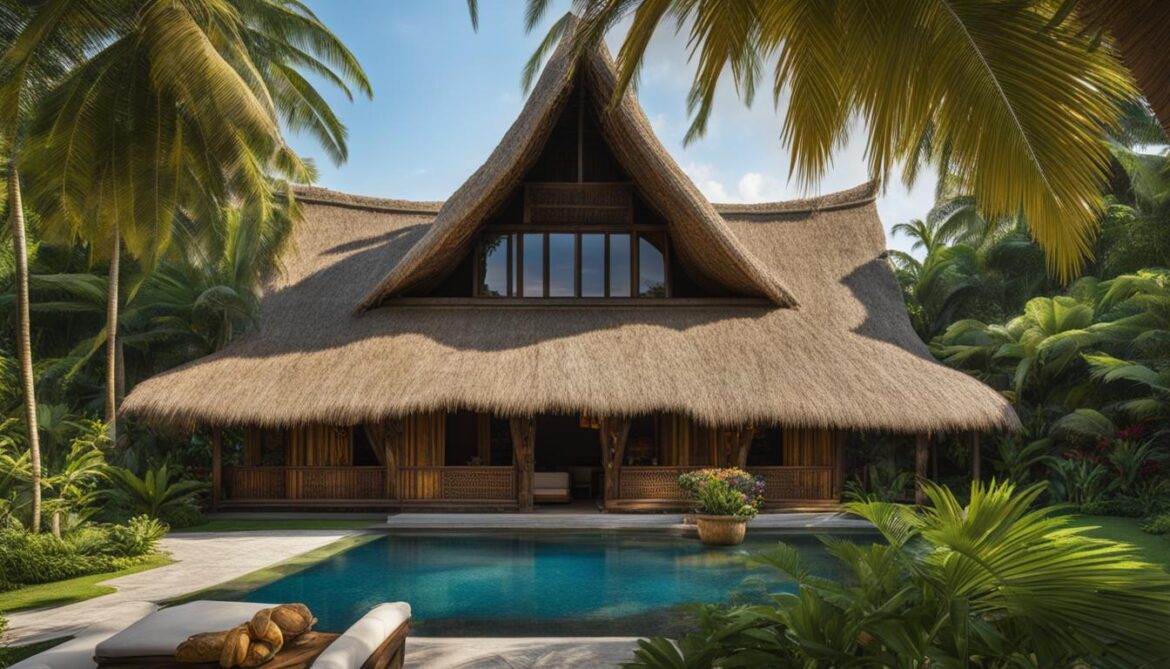
Key Features of Traditional Samoan Architecture:
- Open structure promoting natural ventilation
- Lashing technique providing flexibility and strength
- Resilience to extreme weather events
- Promotion of social cohesion and effective governance
- Preservation of cultural heritage
Challenges of Western-style Buildings in Samoa
Western-style buildings in Samoa face several challenges, particularly when it comes to their vulnerability to cyclones and other severe weather events. These buildings, which make up the majority of structures in the country, are often not designed with the tropical climate in mind, making them more prone to roof damage and structural failure.
One of the primary concerns with Western-style buildings in Samoa is their vertical rigid walls, which can be easily susceptible to cyclone winds. The force of these winds can lead to significant roof damage and compromise the overall integrity of the structure. In contrast, traditional Samoan architecture, characterized by its open fale structures, offers better resilience to extreme weather events such as cyclones. The open design allows for the passage of strong winds, reducing the risk of damage.
An additional challenge with Western-style buildings is the construction techniques used. These buildings rely on multiple points of connection from the foundation to the roof, which can contribute to their vulnerability. In contrast, traditional Samoan fale construction utilizes a lashing technique that provides flexibility and strength, making them more resistant to extreme weather events.
Table: Comparison of Building Vulnerability
| Building Type |
Vulnerability to Cyclones |
Construction Techniques |
| Western-style buildings |
High |
Rely on multiple points of connection |
| Traditional Samoan fale |
Low |
Utilize lashing technique for flexibility and strength |
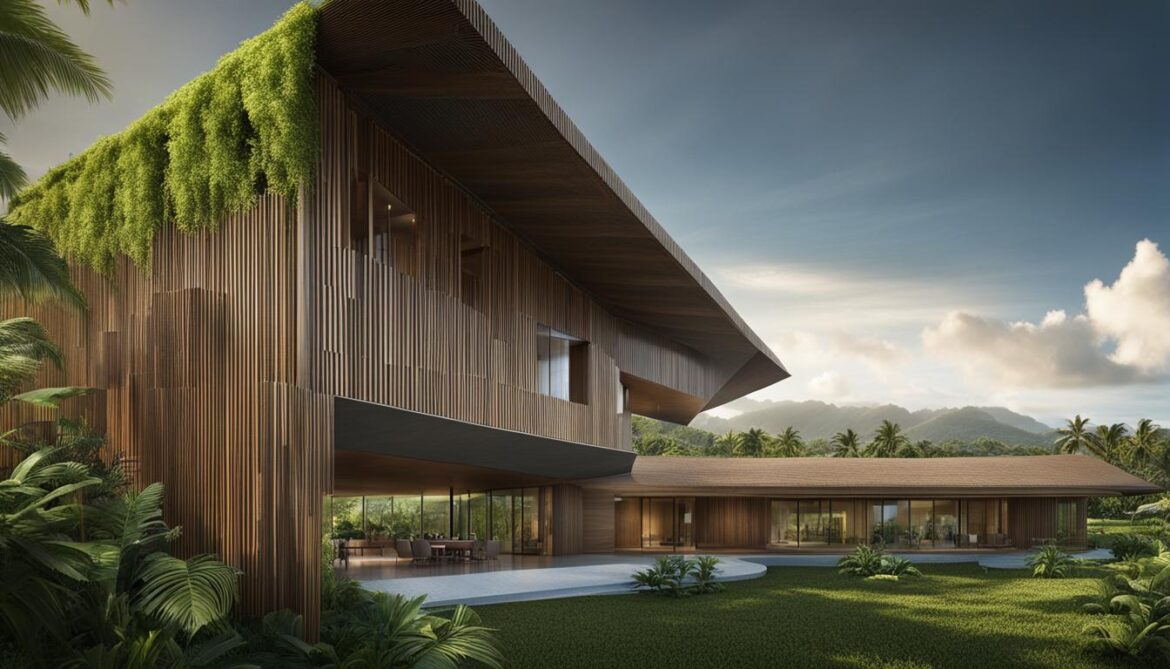
“The vertical rigid walls of Western-style buildings in Samoa can be easily susceptible to cyclone winds, leading to roof damage and structural failure.”
Samoa recognizes these challenges and is actively working towards building back better by promoting the use of sustainable and resilient building techniques. By embracing traditional Samoan architecture and incorporating sustainable features, such as those seen in the Sa’anapu Community Center, the country aims to create buildings that are more resilient to the impacts of climate change and extreme weather events.
Sustainable Accommodation in Samoa: Exploring Eco-Friendly Stays
When visiting Samoa, travelers have the opportunity to choose sustainable accommodation options that minimize environmental impact and promote conservation of natural resources. These eco-friendly stays prioritize the use of renewable energy sources and contribute to a greener future. One unique type of accommodation in Samoa is the fale, a traditional wooden bungalow that allows guests to immerse themselves in the natural beauty of the island while supporting local communities. Staying in fales often includes meals sourced from local farmers, further benefiting the local economy and reducing carbon footprints.
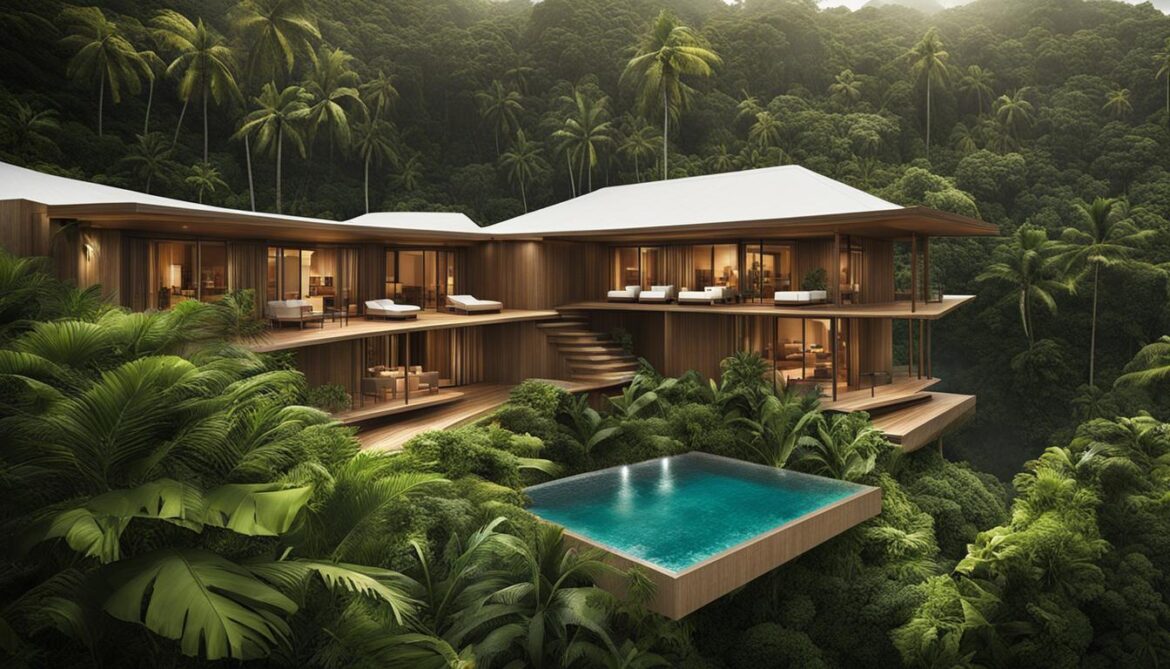
By opting for eco-friendly accommodation, travelers can enjoy a sustainable and authentic experience in Samoa.
Benefits of Choosing Sustainable Accommodation:
- Minimizes environmental impact
- Promotes conservation of natural resources
- Supports local communities
- Reduces carbon footprints
“Choosing sustainable accommodation in Samoa not only benefits the environment but also supports the local economy and offers a unique cultural experience.”
Whether it’s staying in a fale, an eco-resort, or a locally owned guesthouse, sustainable accommodation options in Samoa allow travelers to contribute to the preservation of the island’s natural beauty while enjoying a memorable and responsible vacation.
| Types of Sustainable Accommodations |
Description |
| Eco-Resorts |
Complete island getaway experience with minimal environmental impact |
| Beach Fales |
Traditional and environmentally friendly bungalows made of natural materials |
| Eco-Lodges |
Focus on preserving natural vegetation and sourcing local food sustainably |
| Guesthouses, Bed and Breakfasts, Motels |
Smaller-scale accommodations that support local businesses and offer a more sustainable alternative to large resorts and hotels |
Sustainable Accommodation in Apia
When visiting Apia, the capital city of Samoa, travelers have the opportunity to choose from various sustainable accommodation options that support local businesses and prioritize environmental preservation. One notable option is the Dave Parker Eco Lodge Hotel, located just a 20-minute drive from the center of Apia. This eco lodge hotel is nestled on a tropical hillside, offering a serene and eco-friendly stay for guests.
The Dave Parker Eco Lodge Hotel provides basic yet comfortable rooms equipped with a small kitchenette and private bathroom, allowing guests to have a self-sufficient and sustainable experience during their stay. The hosts of the hotel provide recommendations on local attractions and eateries, ensuring that guests can explore Apia while supporting the local community.
By choosing to stay at the Dave Parker Eco Lodge Hotel, travelers can enjoy a memorable and eco-friendly experience in Apia while contributing to the preservation of Samoa’s natural beauty and resources.
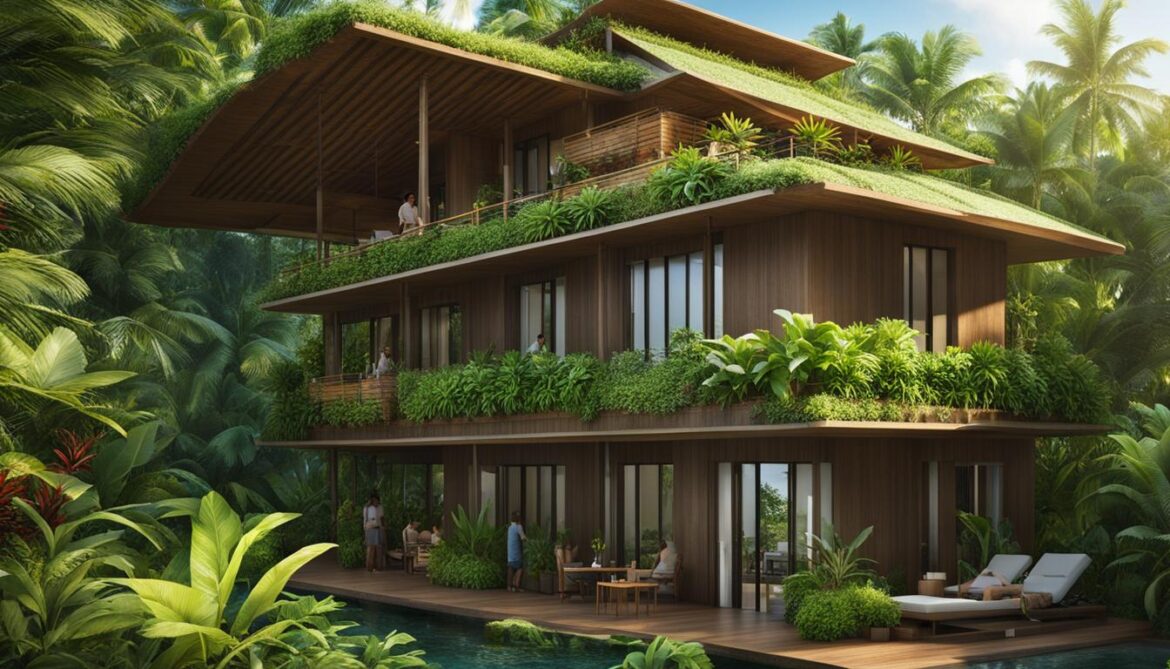
Table: Comparison of Sustainable Accommodations in Apia
| Accommodation |
Location |
Features |
Price Range |
| Dave Parker Eco Lodge Hotel |
Tropical hillside, 20 minutes from Apia center |
Basic yet comfortable rooms with kitchenette and private bathroom |
££ |
| Eco Resort Apia |
Coastal area, near Apia |
Luxurious eco-friendly rooms, on-site farm-to-table restaurant, spa, and wellness facilities |
£££ |
| Apia Guesthouse |
In the heart of Apia |
Cozy guestrooms, communal kitchen and dining area, shared bathrooms |
£ |
Exploring the South Coast of Upolu: Sustainable Accommodation Options
The South Coast of Upolu in Samoa offers a range of sustainable accommodation options for travelers seeking a unique and eco-friendly experience. Two notable choices are the Maninoa Beach Fales and the Sinalei Reef Resort & Spa.
Maninoa Beach Fales
Maninoa Beach Fales provides guests with the opportunity to stay in open beach fales or beach cabins, allowing for a close connection with nature. These accommodations are locally owned and run, supporting the local community and preserving traditional Samoan architecture. The beach fales offer a unique experience, where guests can fall asleep to the sound of ocean waves and wake up to breathtaking views of the beach. It’s the perfect choice for those who want to immerse themselves in the natural beauty of Samoa while minimizing their environmental impact.
Sinalei Reef Resort & Spa
Sinalei Reef Resort & Spa is a 4-star eco-resort that combines luxury with sustainability. The resort takes pride in its eco-friendly initiatives, which include the utilization of renewable energy sources, supporting local farmers, and actively participating in community development projects. Guests can indulge in the resort’s various amenities, including a private beach, spa, and organic garden. By choosing Sinalei Reef Resort & Spa, travelers can enjoy a high level of comfort while contributing to sustainable tourism practices in Samoa.
Comparing Maninoa Beach Fales and Sinalei Reef Resort & Spa
| Accommodation |
Features |
Benefits |
| Maninoa Beach Fales |
– Open beach fales and beach cabins |
– Close connection with nature
– Locally owned and run, supporting the local community
– Preservation of traditional Samoan architecture |
| Sinalei Reef Resort & Spa |
– 4-star eco-resort with luxury amenities |
– Utilization of renewable energy sources
– Support for local farmers
– Active involvement in community development projects |
Both Maninoa Beach Fales and Sinalei Reef Resort & Spa offer unique sustainable accommodation options on the South Coast of Upolu in Samoa. Whether you prefer a more rustic experience or a luxurious getaway, there is an option to suit your preferences while supporting sustainable tourism practices. Whichever you choose, you can rest assured that your stay will contribute to environmental preservation and the well-being of local communities.
Sustainable Accommodations in Samoa
When planning a trip to Samoa, eco-conscious travelers have a variety of sustainable accommodations to choose from. Whether you prefer the luxury of an eco-resort, the charm of a beach fale, or the comfort of a guesthouse, there is an option to suit every preference and budget.
Eco-Resorts
Eco-resorts in Samoa are committed to minimizing their environmental impact while providing guests with a luxurious and sustainable experience. These resorts implement eco-friendly policies and utilize renewable energy sources, such as solar power, to reduce their carbon footprint. With amenities ranging from private villas to spa facilities, eco-resorts offer a complete island getaway experience while promoting sustainable tourism practices.
Beach Fales
For a truly authentic experience, consider staying in a beach fale. These traditional open structures, made of natural materials like wood and thatch, allow guests to immerse themselves in the stunning beauty of Samoa’s coastline. Beach fales are locally owned and operated, supporting the local community and preserving traditional architecture. Waking up to the sound of waves and falling asleep under the stars, beach fales offer a unique and sustainable accommodation option.
Guesthouses, B&Bs, and Motels
If you prefer a more intimate and local experience, guesthouses, bed and breakfasts, and motels are excellent choices. These smaller-scale accommodations support local businesses and offer a more sustainable alternative to large resorts and hotels. With personalized service and a focus on community engagement, staying in a guesthouse or B&B allows you to connect with the local culture and contribute directly to the livelihoods of Samoan families.
| Accommodation Type |
Description |
| Eco-Resorts |
Eco-friendly luxury resorts committed to minimizing environmental impact and utilizing renewable energy sources. |
| Beach Fales |
Traditional open structures made of natural materials, offering an authentic experience close to nature. |
| Guesthouses, B&Bs, and Motels |
Smaller-scale accommodations that support local businesses and provide personalized service. |
Whichever sustainable accommodation you choose in Samoa, you can rest easy knowing that your stay supports local communities and contributes to the preservation of this beautiful island nation.
What to Look for in Sustainable Accommodation
When choosing sustainable accommodation for your stay, it’s important to consider environmental initiatives that go beyond surface-level claims. Look for accommodations that prioritize sustainability and implement practices that reduce their environmental impact.
Environmental Initiatives
One key factor to look for is the use of non-toxic cleaning agents. These agents are safer for the environment and promote a healthier indoor environment for guests. Additionally, check if the accommodation utilizes renewable energy sources such as solar power. This helps reduce reliance on fossil fuels and minimizes carbon emissions.
Recycling Programs
Another important aspect to consider is whether the accommodation has recycling programs in place. Recycling helps reduce waste and promotes the responsible use of resources. Accommodations that provide bulk biodegradable toiletries also contribute to a more sustainable stay.
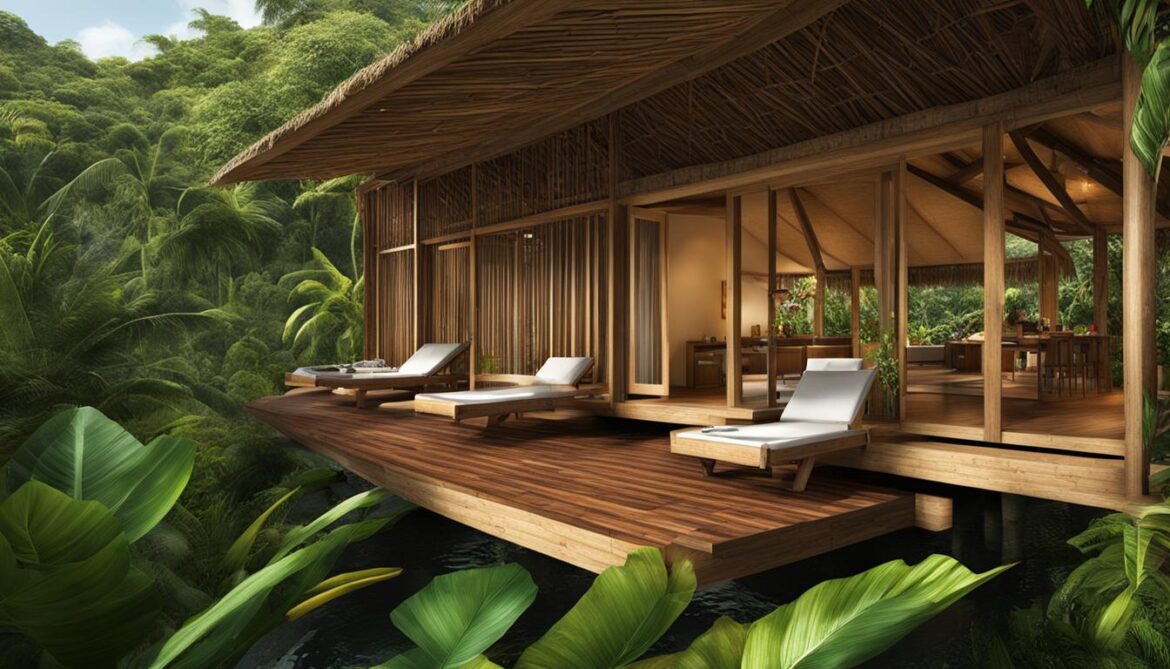
Additional Features
Some sustainable accommodations may incorporate additional features to further reduce their environmental impact. This can include composting toilets, locally sourced construction materials, and green transportation options. These features contribute to a more sustainable and eco-friendly experience.
By considering these factors, you can make informed choices and support accommodations that align with your commitment to sustainability. Enjoy your stay in Samoa while minimizing your environmental footprint!
Planning Your Sustainable Stay in Samoa
To make the most of your sustainable stay in Samoa, it is essential to plan your itinerary, consider eco-friendly transport options, explore the attractions, and choose suitable accommodations.
When creating your itinerary, you can start by selecting a main destination or designing a travel plan that includes multiple regions of the country. Samoa offers a rich variety of landscapes, from pristine beaches to lush rainforests, so you can tailor your itinerary to your preferences and include activities that align with sustainable tourism practices.
To minimize your carbon footprint, opt for eco-friendly transport options such as electric vehicles or bicycles. Not only will this reduce your emissions, but it will also allow you to explore the natural beauty of Samoa at a leisurely pace, enjoying the scenery and connecting with the local environment.
When selecting attractions to visit, take into account their sustainability initiatives and their commitment to preserving nature and local culture. Many attractions in Samoa offer guided tours that educate visitors about the importance of conservation and sustainable practices. By supporting these attractions, you contribute to the preservation of Samoa’s natural and cultural heritage.
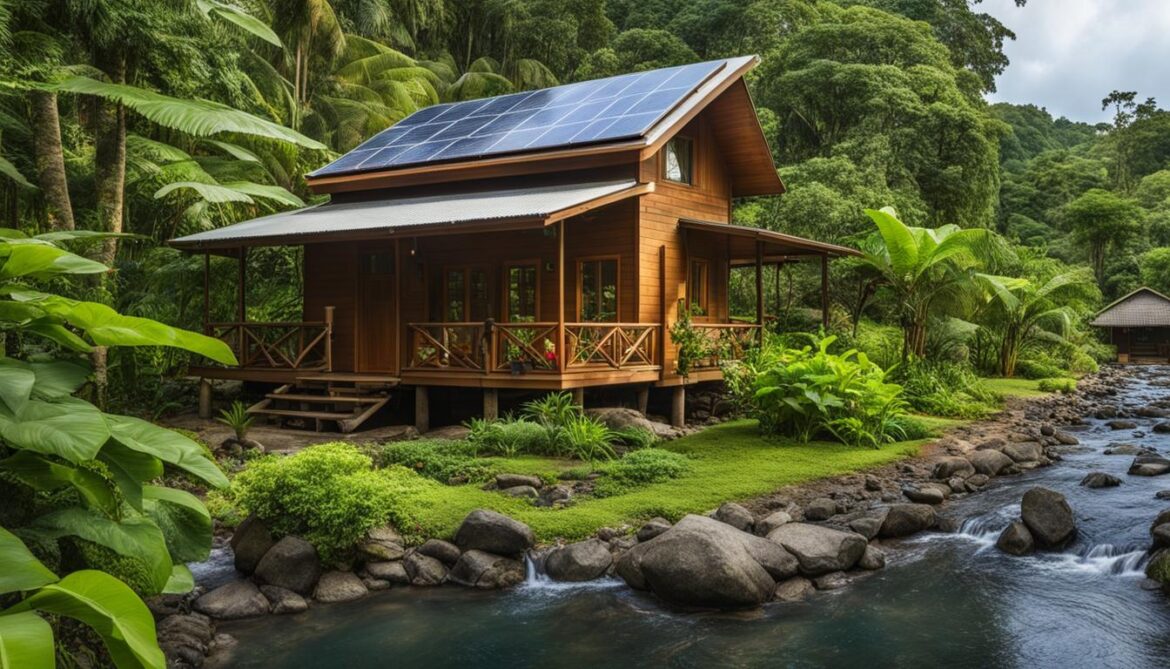
Sustainable Accommodations in Samoa
| Accommodation |
Location |
Sustainability Features |
| Eco Paradise Beach Resort |
Savai’i |
Powered by renewable energy, organic gardens, sustainable waste management |
| Seabreeze Resort |
Upolu |
Solar-powered, eco-friendly practices, support for local community projects |
| Aganoa Lodge Samoa |
Savai’i |
Off-grid, sustainable construction, locally sourced food |
Choosing suitable accommodations is crucial for a sustainable stay in Samoa. Look for accommodations that prioritize sustainability by implementing eco-friendly practices, using renewable energy sources, and supporting local communities. Eco Paradise Beach Resort in Savai’i, for example, is a great option that combines comfort with environmental consciousness. Powered by renewable energy and featuring organic gardens, this resort is committed to sustainable practices. Seabreeze Resort in Upolu is another eco-friendly choice, with solar-powered facilities and a focus on supporting local community projects. Aganoa Lodge Samoa in Savai’i offers a unique off-grid experience, with sustainable construction practices and locally sourced food.
Conclusion
Samoa is at the forefront of sustainable architecture and eco-friendly construction practices, prioritizing environmental preservation and sustainable tourism. By fusing traditional Samoan architecture with modern features and incorporating renewable energy systems, the country is spearheading the development of environmentally friendly buildings. These structures are not only resilient to natural disasters but also promote the use of sustainable materials and energy sources.
Furthermore, Samoa’s commitment to sustainable development extends to the tourism industry. The availability of sustainable accommodations offers travelers the opportunity to support local communities while enjoying a greener travel experience. By choosing eco-friendly stays, visitors can contribute to a more sustainable tourism sector and help preserve the natural beauty of the Samoan islands.
With its focus on sustainable architecture, eco-friendly construction, environmental preservation, and sustainable tourism, Samoa serves as an inspiration and example for other nations striving to create a greener future. Through these efforts, Samoa is not only protecting its unique cultural heritage but also ensuring a sustainable and resilient future for generations to come.
FAQ
What is sustainable architecture?
Sustainable architecture is an approach to building design that focuses on minimizing the environmental impact of structures by utilizing eco-friendly construction practices, energy-efficient design, and green building materials.
What are green building materials?
Green building materials are materials that are sustainably sourced, have a low impact on the environment, and promote energy efficiency. Examples include recycled materials, responsibly harvested wood, and non-toxic paints.
What are green building practices?
Green building practices refer to construction techniques that prioritize environmental sustainability. This includes energy-efficient design, waste reduction, water conservation, and the use of renewable energy systems.
What are the benefits of renewable energy systems in buildings?
Renewable energy systems, such as solar panels or wind turbines, generate clean and sustainable energy. By incorporating these systems into buildings, they can reduce reliance on fossil fuels, lower energy costs, and decrease carbon emissions.
How does sustainable development contribute to a greener future?
Sustainable development focuses on meeting the needs of the present without compromising the ability of future generations to meet their own needs. By implementing eco-friendly practices and preserving natural resources, sustainable development promotes environmental preservation and long-term sustainability.
What are environmentally friendly buildings?
Environmentally friendly buildings, also known as green buildings, are designed and constructed to have minimal impact on the environment. They utilize sustainable materials, energy-efficient systems, and eco-friendly practices to reduce energy consumption, conserve water, and promote a healthy indoor environment.
How do traditional Samoan architecture and sustainable design blend together?
Traditional Samoan architecture, with open structures called “fales” and a lashing technique for construction, offers natural resilience to extreme weather events. By incorporating sustainable features like solar energy and water tanks into traditional designs, Samoa blends indigenous building practices with modern technology for environmentally friendly and disaster-resilient buildings.
What are the benefits of staying in sustainable accommodations?
Staying in sustainable accommodations minimizes environmental impact by prioritizing renewable energy sources, reducing waste, and supporting local communities. It allows travelers to enjoy a more authentic and environmentally responsible experience.
How can I ensure I am choosing a sustainable accommodation?
Look for accommodations that utilize renewable energy sources, have recycling programs, and use non-toxic cleaning agents. You can also consider accommodations that support local businesses, source food sustainably, and implement eco-friendly initiatives such as composting toilets or green transportation options.
How can I plan a sustainable stay in Samoa?
Start by selecting destinations that offer sustainable accommodation options. Consider eco-friendly transport options like electric vehicles or bicycles and choose accommodations convenient to the attractions you want to visit. Prioritize sustainable accommodations that support local communities and promote environmental preservation.
Source Links






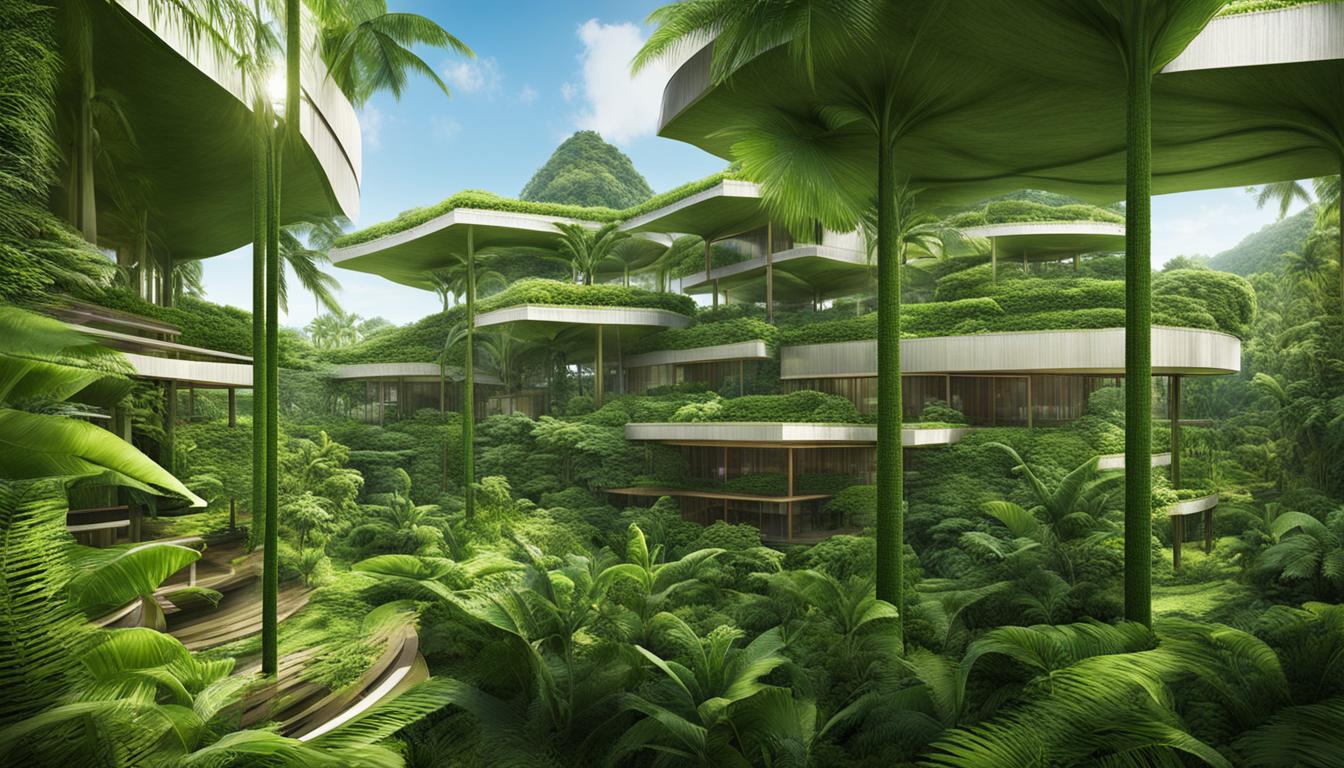

















Post comments (0)